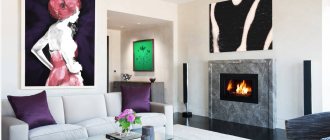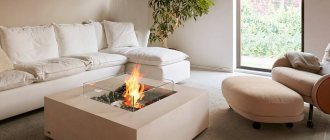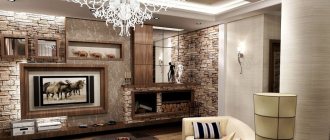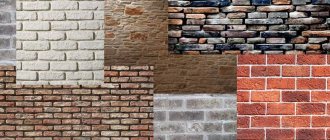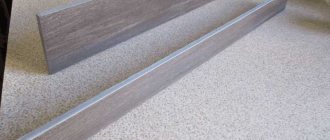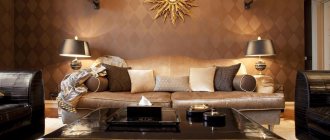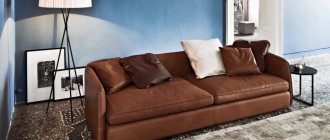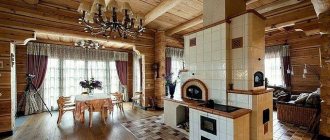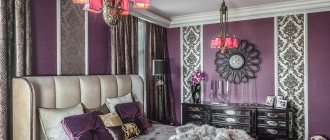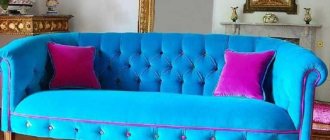Types of fireplaces: which models can be installed in wooden houses
If we take the basic material as a basis, such housing can be equipped with the following types of fireplaces:
- from oven bricks . The structures are characterized by large dimensions and significant weight; they require the laying of a separate foundation that is not combined with the base of the walls. Brick exhibits high heat capacity; it is capable of heating a room for a long time and evenly. The thickness of the masonry closest to the wall must exceed 25 cm; it is isolated from the wood using a layer of basalt wool, vermiculite or perlite;
- with a metal firebox - steel or cast iron. Often structures include a glass door, resulting in something between a functional stove and a fireplace. The efficiency of modern variations can reach 80%, the advantages of the solution are compactness, accessibility, and ease of installation. Metal fireboxes are introduced into decorative fireplaces made of artificial or natural stone, wood, brick, chimneys are masked with plasterboard sheathing;
- stone _ It is less common due to the complexity of the arrangement and the need for a foundation; it is installed in spacious rooms.
An urban metal solution embodied in a spacious country house Source pinterest.com
The criteria of shape and location allow us to distinguish several groups:
- corner . They are compact, they are optimal for small houses;
- isolated . They usually have a free-standing design, are made in a square, round, rectangular shape; the firebox can be open or closed. Products require free space; they are often ordered to be placed in the center of the living room;
- straight . They are divided into wall-mounted and built-in, the former are mounted against the wall, the latter are usually used to serve two rooms.
A neat built-in fireplace with a glass screen in a spacious living room Source pinterest.co.uk
According to the type of fuel used, fireplaces are:
- classic solid fuel . They use coal and firewood, and it is customary to design them together with a firewood shed. Structures need insulation of all floors and adjacent surfaces;
- electric ones are complemented by imitation of live fire. Fireproof fireplaces are installed in the attics of wooden houses and on the upper floors; the products do not require a chimney or their own foundation;
- biofireplaces operate on ethanol and perform only aesthetic purposes;
- gas fireplaces , like classic ones, require the installation of a full firebox and chimney system.
The light design, which is not typical for the interior decoration of wooden houses, echoes the cladding of a solid fuel fireplace Source ar.aviarydecor.com
Electric variations can heat the room, while alternative bio-fireplaces cannot.
See also: Catalog of wooden house projects presented at the Low-Rise Country exhibition.
The best wood burning stoves
Guca Lava
A closed-type floor-standing fireplace stove allows you to heat residential private and country houses . Heat begins to flow into the rooms after 15-20 minutes, and the long-burning system maintains it for 8 hours from one load of firewood.
Equipped with a cast iron hob of an unusual shape, with the ability to place 2 containers on it.
The model has gained popularity thanks to its cast iron body, which perfectly accumulates heat and distributes it evenly throughout the room.
Characteristics:
- heating volume - 240 m3;
- power - 12 kW;
- there is a chimney with a diameter of 12 cm, top connection;
- Efficiency - 78.1%
- fuel type - firewood;
- there is a box for ash;
- material of the body, firebox and top panel - cast iron, doors - glass;
- dimensions - 54x94.6x49.3 cm;
- weight - 155 kg.
Advantages:
- large sizes of facade glass;
- “clean glass” system;
- “long burning” system;
- system of “secondary combustion of carbon monoxide” to increase efficiency;
- economical consumption of firewood;
- attractive appearance;
- suitable for installation anywhere in the room;
- strong and durable housing.
Flaws:
- unfinished ash pit design;
- uncomfortable handles.
Kratki Koza K9
This is a closed floor cast iron fireplace stove for a summer house and country house . The wall thickness is 8 mm, cast from gray cast iron. They allow you to evenly distribute heat throughout the entire area of the room.
Adjusting the combustion air supply reduces the burning time of wood.
Not only firewood, but also coal briquettes are used as fuel.
It has a unique appearance - each structural element is cast from cast iron and has a complex “carved” shape.
The stove will fit perfectly into any interior of the room, and the panoramic door will open up a wonderful view of the play of fire.
Characteristics:
- heating volume - 250 m3;
- power - 13 kW;
- there is a chimney with a diameter of 15 cm, rear and top connections;
- Efficiency - 78%;
- fuel type - firewood (min. length - 35 cm), coal briquettes;
- there is a box for ash;
- body material - cast iron, doors - glass;
- dimensions - 76.6x66x54.6 cm;
- weight - 160 kg.
Advantages:
- fast heating of the area;
- not demanding on the type and quality of firewood;
- spacious firebox;
- the door consists of triple glass;
- “clean glass” system;
- efficient removal of combustion products;
- environmental friendliness, safety of use.
Flaws:
- rapid blackening of glass;
- smoke transmission is observed;
- The chimney gets clogged quickly.
La Nordica Nicoletta
This is a reliable and convenient heating device . The uniqueness lies in the exquisite Italian design - the stove body can be burgundy, beige or cream.
The complex air flow system is designed for use of the fireplace in smoldering mode, long burning.
The floor structure acts as an independent heating equipment and works perfectly in tandem with central heating.
The wide chimney is easy to clean and quickly removes combustion products from the room.
Characteristics:
- heating volume - 229 m3;
- power - 8 kW;
- there is a chimney with a diameter of 13 cm, top connection;
- Efficiency - 80.9%;
- fuel type - firewood;
- body material - cast iron, doors - glass;
- dimensions - 58.7x98x57.2 cm;
- weight - 168 kg.
Advantages:
- quick heating of rooms;
- long-term heat retention;
- there is a compartment for storing firewood;
- stylish design;
- safety of use;
- high quality of the device and practicality;
- the glass remains clean after several ignitions;
- Ceramic lining prevents injuries to adults and children.
Flaws:
- No.
La Nordica Ghisa Isotta Con Cerchi
Floor-standing model for heating residential premises . Can operate with central heating. Double cast iron walls protect the body from burning through, which affects the durability of the stove.
The peculiarity is the presence of a full-fledged hob, complemented by a protective cover.
Uniqueness - the presence of a side door for loading firewood, an easy ignition function, summer operation (plays the role of a cooking stove).
Characteristics:
- heating volume - 338 m3;
- power - 11.9 kW;
- there is a chimney with a diameter of 15 cm, rear connection;
- Efficiency - 82%;
- fuel type: wood with a maximum length of 30 cm;
- firebox volume - 62.3 l;
- functions - flame adjustment, clean glass, long burning, secondary combustion;
- complete with ash drawer and hob;
- body and firebox material - cast iron, doors - glass;
- dimensions - 79x83x66 cm;
- weight - 216 kg.
Advantages:
- highest quality cast iron;
- large door with panoramic view;
- handle for contactless cleaning of the grate;
- convenient fuel loading;
- sealed firebox;
- functionality;
- environmental friendliness;
- economical consumption of firewood.
Flaws:
- instant glass contamination during slow burning;
- cools down quickly after the wood burns out.
Brandenburg Brandenburg with cast iron stove
This is a floor-standing stove made of cast iron, steel and ceramics . The combination of materials made it possible to obtain a high-performance model that releases heat 15 minutes after laying firewood.
The door is manufactured using direct glazing technology, which is used only in Germany and Japan.
The oven is ideal for cooking, since the cast iron hob heats up to +200 degrees.
Characteristics:
- heating volume - 120 m3;
- power - 9 kW;
- there is a chimney with a diameter of 11.5 cm, rear connection;
- fuel type - firewood;
- functions - secondary afterburning, clean glass, long burning;
- body material - steel, doors - glass, cladding - ceramics;
- dimensions - 56x84x46 cm;
- weight - 118 kg.
Advantages:
- plays the role of a full-fledged tile;
- the cladding is covered with fireclay;
- environmental friendliness;
- safe operation;
- has a fuel storage compartment;
- resistance to high temperatures.
Flaws:
- small firebox volume;
- cools down quickly;
- unfinished long-burning system.
Invicta Chamane
A French model with a youthful, sophisticated design . It is made of cast iron, so it instantly heats a large area and maintains heat for 10 hours.
Acts as an independent heat source or can function in conjunction with central heating.
The locking handle in the form of a large comma hermetically locks the firebox, does not allow the fire to escape beyond the chamber, and perfectly complements the designer’s idea.
Characteristics:
- heating volume - 190 m3;
- power - 14 kW;
- there is a chimney with a diameter of 18 cm, top connection;
- fuel type - firewood with a maximum length of 33 cm;
- Efficiency - 78.8%;
- functions - secondary afterburning, long burning - 10 hours, clean glass;
- complete with ash box;
- body material - cast iron, doors - glass;
- dimensions - 57.8x120x56 cm;
- weight - 160 kg.
Advantages:
- large panoramic glass;
- efficient and fast heating;
- uniform heat distribution;
- magnificent author's design;
- easy chimney installation;
- high-quality removal of combustion products;
- environmental friendliness and safety of use.
Flaws:
- cools down quickly;
- Ashes fly away.
EcoFireplace Bavaria
This product was developed according to high European quality technologies, but by a domestic manufacturer . The stove is easy to install and has great power capabilities.
After installation, the owner receives comfortable warmth and a wonderful panorama of live fire.
The fireplace operates in continuous burning mode for up to 5 hours, acting as the main source of heat.
Equipped with a hob for preparing various dishes and heating the kettle.
Characteristics:
- power - 9 kW;
- there is a chimney with a diameter of 15 cm, top connection;
- fuel type - firewood;
- complete with ash drawer and fuel storage tank;
- construction material - cast iron, doors - glass;
- dimensions - 59x86x47.5 cm;
- weight - 126 kg.
Advantages:
- fast and uniform heating of the room;
- the quality and type of firewood does not matter;
- interesting design;
- large panoramic glass;
- sealed housing;
- safe operation and environmental friendliness.
Flaws:
- glass gets dirty quickly;
- The door is not fully finished.
Guca Mercury
Cast iron model with fireproof glass door . The stove is equipped with primary and secondary air regulators that regulate the amount of supplied air for high-quality combustion.
In this case, the primary must be open for the ignition time - 15-20 minutes.
When a stable combustion mode is achieved, it closes. This allows you to achieve fuel savings and high-quality room heating.
A secondary regulator is necessary to keep the glass clean and improve the subsequent combustion process.
Characteristics:
- heating volume - 250 m3;
- power - 13 kW;
- Efficiency - 82%;
- there is a chimney with a diameter of 12 cm, top and rear connections;
- functions - clean glass;
- complete with hob;
- dimensions - 57.8x53.5x39 cm;
- weight - 110 kg.
Advantages:
- ability to set long burning mode;
- The hob does an excellent job of cooking;
- uniform heating of rooms;
- large glass;
- beautiful appearance;
- not being picky about the type and quality of firewood;
- environmental friendliness, safe operation.
Flaws:
- the door does not lock;
- no ash drawer.
Teplodar Vertical ceramics
Heating and cooking device for heating living areas . With its compact size, it efficiently heats rooms and operates in a long-burning system.
Maintains heat on one stack of firewood for up to 8 hours.
Equipped with special heat sinks to which ventilation corrugated hoses are connected . They are suitable for warming adjacent rooms.
Decorative convector made of ceramic tiles.
The material can be easily changed for a better combination with the overall interior.
Characteristics:
- heating volume - 120 m3;
- there is a chimney with a diameter of 11.5 cm, rear and top connections;
- functions - long burning system, 8 hours;
- complete with ash pan;
- body material - steel, fireboxes - cast iron, doors - glass;
- dimensions - 37.5x88x42.5 cm;
- weight - 44 kg.
Advantages:
- full cast iron stove;
- efficient double-turn stainless steel chamber;
- compact size and light weight;
- there are heat sinks on the rear side of the case;
- ceramic convector;
- fuel economy;
- environmental friendliness, safety.
Flaws:
- heat is observed only when wood is burning;
- The stated burning time is not true.
THORMA Milano II
An attractive stove with high heating performance in residential areas . It has gained popularity for its versatility and excellent design.
Available in a wide color palette - black, beige, white, burgundy.
Each buyer can choose an excellent solution for themselves, according to the overall interior of the room.
Fireproof triple glass prevents smoke from entering the room and opens a panoramic view of the play of fire.
Characteristics:
- heating volume - 124 m3;
- power - 5 kW;
- Efficiency - 72%;
- there is a chimney with a diameter of 12 cm, rear connection;
- functions - secondary combustion, flame adjustment, clean glass, long burning;
- complete with ash pan and hob;
- case material - steel;
- dimensions - 38x89x36 cm;
- weight - 72 kg.
Advantages:
- afterburning of flue gases;
- You can use firewood up to 40 cm long;
- spacious ash pan;
- there is a mechanism for dumping ash;
- two convection chambers;
- the cooking surface is complemented by a cast iron lid;
- keeping the room clean.
Flaws:
- No.
Fireproof installation of a fireplace in a wooden house
The fireplace should not be located opposite the openings: a draft from a door or window will cause smoke. When deciding how to install a fireplace in a wooden house, it is worth remembering that the floor in the active zone must be lined with materials that are not afraid of sparks and coal - stone tiles, metal sheets, porcelain stoneware. Introducing a stove into a small room is impractical; large volumes of oxygen are required to maintain combustion.
In order for a wooden house to gain stability and completely undergo natural shrinkage, you need to wait at least 3 years between the end of its construction and the start of installation of the fireplace. In this case, the risk of displacement or problems with the removal of combustion products will be minimized. Experts also note that according to safety standards, the installation of open fireboxes is prohibited on upper floors.
According to fire safety requirements, the space in front of the fireplace is lined with facing tiles Source hi.aviarydecor.com
A wooden floor is not suitable as a base for a structure; the foundation for the stove must be separated. It is necessary to provide a place in the room to place a fire extinguisher. The stove should not be installed next to windows decorated with curtains, curtains, and proximity to upholstered furniture is also undesirable.
Special attention is paid to insulating wooden surfaces to protect them from heat and sparks. Materials such as basalt wool, sheets of mineral insulation supplemented with a reflective screen, and rolled non-flammable synthetic compounds can be used here. If the chimney penetrates the ceiling, it must be wrapped in fire-resistant wool with a foil film.
See also: Catalog of companies that specialize in the installation of fireplaces and stoves.
Types of furnaces
In our country, many types of furnace equipment are built and operated; we list some:
- Swede
- Dutch
- Baby
- Heating and cooking
- Fireplace
- Stove with fireplace.
Types of stoves
Despite the difference in design, all stoves are characterized by the following parameters:
- Purpose.
- Maximum oven heating temperature.
- Duration of fuel combustion.
- The time required for the structure to warm up and begin full heat transfer.
- Smoke exhaust device.
- Scheme of the movement of warm gases through channels arranged in the furnace body.
- Oven shape.
- Options for finishing external walls.
- Material used in the construction of the furnace.
Stoves installed in homes have ancient traditions. Our distant ancestors cooked food on it, heated their homes with it, and used it as a sleeping place.
Video description
Video example of professional installation of a metal fireplace in a finished wooden house:
All work can be divided into main stages:
- Arrangement of the foundation . It is isolated from the foundation of the house, but is poured simultaneously with the latter even before the construction of housing begins. If it is necessary to introduce a fireplace into an already completed structure, craftsmen remove the floor covering and dismantle part of the ceilings. The depth of the pit should reach the freezing line of the soil; a layer of crushed stone and broken brick is formed at the bottom. The finished height of the formwork should exceed the floor level by 10 cm. When pouring the solution, reinforcing ligaments are used, leveled, and waterproofed after hardening.
- Preparing the walls . They are sheathed with insulating materials, often in multilayer form. The sheets are fixed on metal guides, the joints are sealed using adhesive foil tape. An alternative solution for insulation could be additional brickwork laid flush against the wall.
- Fireplace assembly . The masonry is carried out according to the project, starting from the base, using a special heat-resistant mortar. The internal surfaces are formed from refractory bricks, the rest from solid bricks. The components that form the firebox and door are gradually introduced.
Assembling a fireplace in a wooden house Source et.aviarydecor.com
Foundation for the stove
If you want to build a fireplace in your home, then first of all you need to think about arranging a foundation for it. A properly executed foundation will ensure its long-term and safe operation. In case of negligence or mistakes made, it will undoubtedly lead to deformations, subsidence of the fireplace, and the appearance of cracks.
The main requirements for the foundation can be defined as follows: reliability and lack of connection with the foundation of the entire building.
The optimal solution would be to build a capital foundation, and it can be built simultaneously with the construction of the foundation for the main building. At the same time, creating a single foundation is unacceptable. The thing is that each foundation is designed for a certain load and as a result they have different shrinkage.
There must be a gap of at least 50 mm between them; it must be filled with sand or other bulk material and compacted thoroughly.
The dimensions of the foundation in plan should be larger than the size of the base of the fireplace. That is, it should protrude from the fireplace by 100 - 150 mm. The depth of occurrence depends entirely on the properties of the soil. Practice shows that for a one-story house it is enough to deepen the fireplace foundation by 0.5 - 0.6 m; if the house is higher, then the depth should accordingly be greater - up to 1 m.
TOP design ideas: what a fireplace might look like in a wooden house
The budget category of projects is based on the use of ready-made metal fireplaces. For their harmonious implementation, it is enough to calculate the compatibility of the models with the characteristics of a particular structure, create a foundation, install components and lay the chimney. Such solutions do not always look like the notorious potbelly stoves: manufacturers offer an assortment of elegant products that can fit into both urban and classic interiors.
A laconic copy that only needs proper installation Source pinterest.com.au
Models mounted in a niche trimmed with stone/brick, on a pedestal, are recognized as slightly more complex in terms of labor and material costs.
Here, when designing, it is necessary to take into account the load created by the material Source fumat.lt
A fireplace in a wooden house, assembled according to an individual design project, belongs to the premium segment. Non-standard shapes predominate here - fireplaces in the form of an elongated oval, having a decorative panel framing the firebox, or a vertical orientation of the active zone.
Stylish solution implemented into the heating system of the house Source pechiexpert.ru
Options for a residential building
When choosing a fireplace, you should first decide on its size. On the one hand, the heating device should not be too large: it will look ridiculous and clutter up the entire room. Therefore, for a miniature room it is necessary to choose a compact version of the unit.
On the other hand, a small fireplace in a large living room will get lost and will not be able to fulfill its function of creating coziness and comfort. For a large room, it is recommended to choose a massive unit made of brick, finished with stone tiles.
Depending on the location, fireplaces are divided into the following types:
- wall-mounted (adjacent to one side of the wall);
- corner;
- island (located in the center of the room);
- built-in (installed only if the house has thick walls that allow a chimney to be placed in them).
Wall mounted
Fireplaces in this category are divided into the following two types:
- Traditional – back adjacent to the wall. This device is massive and compact, so it is suitable for rooms of various sizes. The heating device has a straight, long shape and the same width from floor to ceiling, while it begins to taper in the chimney area. The design of the fireplace, depending on the decor of the room and his preferences and tastes, is chosen by the owner.
- Less commonly used is a wall-mounted option, with its side adjacent to the wall. This model is used when they want to divide a room into 2 separate zones.
Wall-mounted fireplaces are usually equipped with a metal firebox, which comes in several types: through and with a blank back wall. The double-sided pass-through design is equipped with doors made of durable fire-resistant glass on both sides. According to fire safety rules, during a fire one door of the device must be tightly closed.
Corner
There are two types of such fireplaces: for external and internal corners. The first type of heating device is installed in a corner and diverges on two sides. The second option is also mounted in the corner of the room, but connects the walls diagonally. Let's look at these two types of equipment in more detail.
- For outside corner. This kind of fireplace is most often installed in a room with an unusual layout and fits much better into the interior of a large room. An example would be two rooms connected to each other and having a common external corner. In this case, a double-sided firebox with fireproof glass doors is installed, which can be used in both rooms.
- For the inside corner. This heating device is suitable for a small room. It does not take up much space and looks massive and monumental. Such fireplaces can have a variety of designs. Depending on the size of the room, it is possible to install additional elements of small architecture.
Wood burning fireplace design
There are three main types of fireplace designs: classic, modern and rustic (rustic). The classic type is based on the stylization of a modern fireplace after antique fireplace samples, with their U-shaped cladding made of natural stone. The combustion chamber is usually closed with a straight glass-ceramic door.
Rustic wood-burning fireplaces for the home have a D-shaped design, a massive wood mantel and a veneer of rough “wild” stone. The chimney is usually hidden by a trapezoidal fireplace mantle.
Modern fireplace design is distinguished, first of all, by bold design solutions and an unusual choice of material for the fireplace lining. It can be glass, polished, satin or rust-painted stainless steel, ceramics and stone.
Wood-burning fireplace operation diagram
The easiest way to illustrate the operation of a wood-burning fireplace with double combustion is using the example of a convection model.
Air passes between the firebox and the fireplace casing, heating up upon contact with the hot walls of the combustion chamber and is released into the environment through convection grilles. The distribution of heated air can be natural or forced - using fans. In the latter case, the use of a regulator is provided, which allows you to change the air supply speed depending on the room temperature. The amount of combustion air, which can be primary, secondary (for glass cleaning) and tertiary (afterburning), can be adjusted using dampers. 1 - primary air inlet for combustion 2 - primary air regulator 3 - primary air inlet into the combustion chamber 4 - secondary air inlet for cleaning glass 5 - air inlet into the furnace for afterburning fuel 6 - gap for hot air circulation 7 - fan for hot distribution air 8 - outlet of hot air into the room 9 - place for connecting the hot air distribution system 10 - ash pan grate 11 - ash pan 12 - outlet pipe for connecting the fireplace to the chimney
Rules for safe operation of the fireplace
How can you use a modern fireplace without any risks? Of course, there are a few important things to keep in mind!
- The walls of the furnace with metal lining and firebox should be located at a distance of 0.5 meters from the walls.
- If the wall is protected with a steel sheet, mineralite or 2.5 - 3 cm plaster, the distance can be reduced to 0.4 meters.
- There should be 1.2 meters from the top of the heating device to the ceiling of the house.
- There should be 1.3 meters from the firebox door to the opposite wall.
- A 0.5-meter sheet of metal will need to be placed in front of the firebox door for a length of 0.7 meters.
